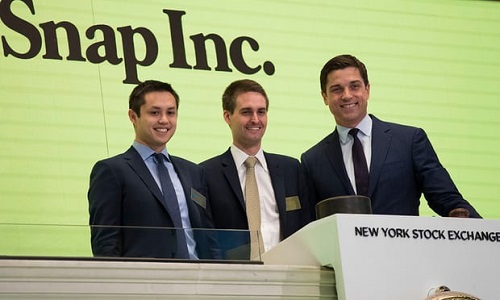Is Snapchat – the social media app famous for its disappearing messages – in danger of doing a vanishing act of its own? It’s a question some are asking after investors turned on the company again this week following a second set of poor results which have turned a once-hot tech company into a stock market casualty.
The losses alone were steep. Snapchat’s parent, Snap Inc, lost $443m over the last three months, compared with $116m in the same period a year ago. Young tech companies are expected to burn through cash at a prodigious rate as they chase customers, but the main worry for shareholders was anaemic user growth, missed revenue targets and the threat from Facebook and Google – both of which have copied some of Snapchat’s key features. Imitation may well be the most sincere form of flattery, but in this case it could also be the most deadly.
On top of these woes, Snap has a money problem. Wall Street cares about revenues in a way that Silicon Valley doesn’t. Life has changed for Snap Inc and its newly minted billionaire co-founder, Evan Spiegel, since the company went public in March.
According to market watchers, the Los Angeles-based business has to work out a way to make money – fast – before rivals eat its lunch. “There is a lot of heavy competition and the company has not figured out how to monetise its audience yet,†said Salvatore Recco, of the advisory firm 50 Park Investments. “Until they do, investors will likely continue to be disappointed.â€
Investors want to know how much money the company will make, and when. This quarter they were let down again. With its young, mobile-obsessed users, Snap offered advertisers a way to reach the all-important millennial market. But the business, whose main offering is a messaging service where people can use filters to change their faces and voices, is not growing the amount of money made per customer as quickly as investors had hoped. Shares in Snap were trading at $12.26 on Friday – nearly half their opening price of $24 when the business floated in March.
Advertisement
Shareholders are always scouring the tech industry for the next Facebook, and Snap is the latest contender for the crown – or at least that was the case when it floated on Wall Street. The only problem is that Facebook is crushing all newcomers. In the second quarter of the year, Snap reported that it had 173 million daily active users. Not only did this undershoot analysts’ expectations of 175 million, but it paled in comparison with the 250 million users of Facebook’s Instagram Stories, where users and businesses can post a string of photos and videos that – like Snapchat messages – disappear after 24 hours.
Snap sees itself as two things: a technology firm reinventing the camera (hence the rebrand to Snap Inc and the creation of its Spectacles camera-glasses), and an MTV for the 21st century, exemplified by its Discover offering, where media brands post mobile phone-friendly content aimed at millennials. But investors don’t really care about the lofty goals that Spiegel reels out in analyst calls. Being the next MTV is all well and good but investors want the next Facebook and all the profit-making opportunities that entails.
The flaw in the plan is that Facebook will not sit back and watch Snap steal its thunder, and after three years of trying to alternately buy, clone and undercut its upstart rival, Facebook’s fightback is starting to have an effect.
Snapchat’s most promising recent launch was Stories, a feature that allows users to post their snaps to a feed that can be viewed multiple times for 24 hours after they’re uploaded. It turned the app from a photo messaging service, still (unfairly) saddled with the brand image of teen sexting, to a fully fledged social network.
In the process, it also managed to appeal to users who had grown up wary of posting images to services which catalogue and archive them indefinitely: no employer will find incriminating Snapchat stories from a decade ago, and no date will scroll through a year’s worth of pictures to spy on ex-lovers.
So Facebook copied it. The company now has four separate clones of Stories, in WhatsApp, Instagram, Messenger and Facebook itself. Three of them are far from popular, but Instagram Stories has soared. According to the data firm Snaplytics, “while Snapchat has had a downward-going slope in terms of influencer activity, Instagram Stories is gaining more and more traction.â€
Advertisement
But it is not all doom and gloom: Snapchat still has far deeper engagement, with the average user spending more than twice the time in the app than the typical Instagrammer. It is also making it easier for advertisers to use the app, analysts say.
This is just as well, because the dream-big plan is struggling. Snap is not taking off as a camera company: the company sold 42,000 camera-spectacles, down 35% on the quarter before. That includes almost a month when the gadget was available outside the US for the first time, leading to vending machines standing forlornly ignored outside tourist attractions in the UK, France, Germany, Spain and Italy.
However, Snapchat’s augmented-reality “lenses†– which superimpose special effects like cartoon dog features on users’ faces – remain genuinely popular and have a greater appeal than similar products from Facebook. Even if you are not on Snapchat, you have probably seen someone’s selfie doctored with dog ears.
Now, Snapchat has a third breakthrough filter: a dancing hotdog, that has gyrated virtually on people’s screens around the world. It has been viewed, according to Evan Spiegel, by 1.5 billion people, making it “the world’s first virtual reality superstarâ€. If grooving meat can be monetised for millions, then Snapchat still has a way out of the doldrums.
Source:theguardian.com





